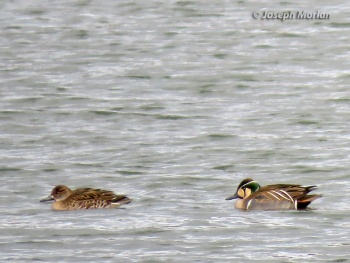(→Identification: Added immature.) |
m (→Identification) |
||
| Line 17: | Line 17: | ||
*Dark crown and eye-stripe | *Dark crown and eye-stripe | ||
'''Immature'''<br /> | '''Immature'''<br /> | ||
| − | Immature males show incomplete white shoulder stripes and have a buffy, not white supercilium. They also lack the white trim along the lower border of the green face patch typical of fully adult males. In this species, some juvenal plumage feathers are known to persist until the following summer<sup>[[#References|[11]]]</sup>, while adults usually attain full plumage by late fall<sup>[[#References|[12]]</sup>. | + | Immature males show incomplete white shoulder stripes and have a buffy, not white supercilium. They also lack the white trim along the lower border of the green face patch typical of fully adult males. In this species, some juvenal plumage feathers are known to persist until the following summer<sup>[[#References|[11]]]</sup>, while adults usually attain full plumage by late fall<sup>[[#References|[12]]]</sup>. |
==Distribution== | ==Distribution== | ||
Revision as of 15:07, 28 April 2019
- Sibirionetta formosa

Photo © by Joseph Morlan
Saku--Saku Regulating Pond, Nagano Prefecture, Japan, 15 February 2019
Identification
39-43 cm (15 ¼-17 in)
- Male:
- Green cap and nape
- Creamy-yellow face
- Pale supercillium
- Pinkish spotted breast
- White vertical line at the side of the breast
- Green speculum with buffish bar above
- Grey flanks
Female and Juvenile:
- Overall brown with bold white lore spot at base of bill.
- Black line from eye to chin
- Dark crown and eye-stripe
Immature
Immature males show incomplete white shoulder stripes and have a buffy, not white supercilium. They also lack the white trim along the lower border of the green face patch typical of fully adult males. In this species, some juvenal plumage feathers are known to persist until the following summer[11], while adults usually attain full plumage by late fall[12].
Distribution
Eastern Siberia to Kamchatka; winters to India, Myanmar and Japan. Casual vagrant to Alaska. Accidental vagrant to Washington and California.
Taxonomy
This is a monotypic species[1]. Formerly placed in genus Anas.
Habitat
Breeds at pools on the tundra edge and within swampy forests. Winters on estuaries, inshore waters, reservoirs and even castle moats.
Behaviour
A dabbling duck
Breeding
They build nests in open tussock meadows near to water. Six to nine pale grey-green eggs are laid.
Diet
They eat seeds, leaves, stems and other vegetative parts of grasses, sedges, aquatic plants and crops (e.g. rice in winter); also aquatic invertebrates.
Vocalisations
Males incessantly produce deep, chuckling sound occasionally in autumn, but more often in spring. Female gives a harsh, low quack.
Movements
Migratory: they winter mainly between mid Nov to late February or early March.
References
- Clements, J. F., T. S. Schulenberg, M. J. Iliff, D. Roberson, T. A. Fredericks, B. L. Sullivan, and C. L. Wood. 2018. The eBird/Clements checklist of birds of the world: v2018. Downloaded from http://www.birds.cornell.edu/clementschecklist/download/
- Peterson, RT, G Mountfort and PAD Hollom. 1993. Collins Field Guide – Birds of Britain and Europe, 5th Revised edition. London: HarperCollins Publishers. ISBN 978-0002199001
- Mullarney, K., Svensson, L., Zetterstrom, D. & Grant, P.J. (1999) Collins Bird Guide, Harper Collins ISBN 0 00 219728 6
- BirdForum Member observations
- BirdLife International 2016. Sibirionetta formosa. The IUCN Red List of Threatened Species 2016: e.T22680317A92855272. http://dx.doi.org/10.2305/IUCN.UK.2016-3.RLTS.T22680317A92855272.en. Downloaded on 22 April 2019.
- Carboneras, C. & Kirwan, G.M. (2019). Baikal Teal (Sibirionetta formosa). In: del Hoyo, J., Elliott, A., Sargatal, J., Christie, D.A. & de Juana, E. (eds.). Handbook of the Birds of the World Alive. Lynx Edicions, Barcelona. (retrieved from https://www.hbw.com/node/52867 on 22 April 2019).
- Chesser, R.T., Burns, K.J., Cicero,C., Dunn, J.L., Kratter, A.W., Lovette, I.J., Rasmussen, P.C., Remsen, Jr., J.V., Rising, J.D., Stotz, D.F., Winker, K. (2017) Fifty-eighth supplement to the American Ornithological Society's Check-list of North American Birds. The Auk: Ornithological Advances 134(3):751–773, https://doi.org/10.1642/AUK-17-72.1
- Gonzalez, J. , H. Düttmann , and M. Wink. 2009. Phylogenetic relationships based on two mitochondrial genes and hybridization patterns in Anatidae. Journal of Zoology 279: 310–318.
- Johnson K.P. & M.D. Sorenson (1999). Phylogeny and biogeography of dabbling ducks (genus Anas): a comparison of molecular and morphological evidence. Auk 116: 792- 805.
- King, J.R. (1999) OrnithoNews: Taxonomy of Anas ducks: Green-winged Teal is a separate species. Birding World 12(6):344.
- Madge, S. & H. Burn (1988) Waterfowl: An identification guide to the ducks geese and swans of the world. Houghton Mifflin
- Palmer, R.S. (1976) Handbook of North American Birds Vol. 2: Waterfowl (Part 1). Yale Univ. Press.
Recommended Citation
- BirdForum Opus contributors. (2024) Baikal Teal. In: BirdForum, the forum for wild birds and birding. Retrieved 2 May 2024 from https://www.birdforum.net/opus/Baikal_Teal
External Links




